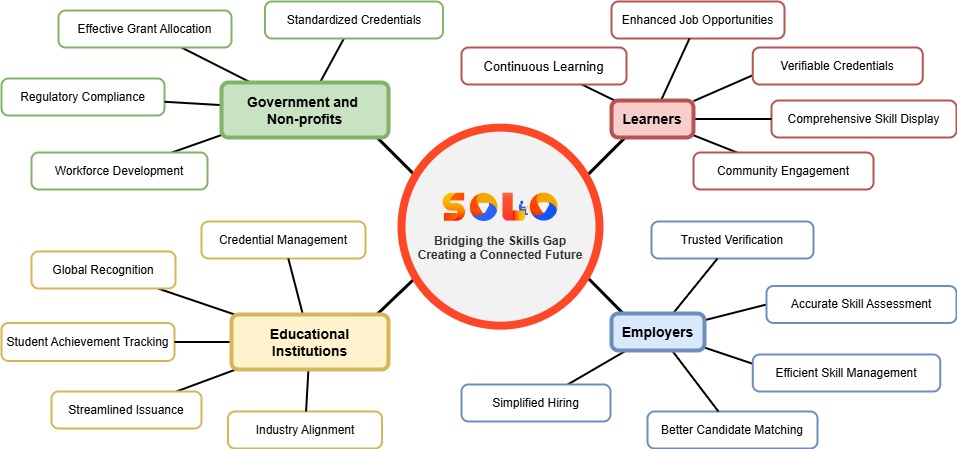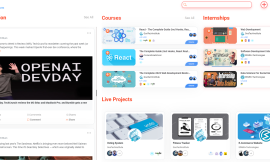In today’s fast-changing job market, there’s a growing disconnect between what we learn and the skills employers need. Traditional methods like resumes and diplomas often don’t tell the full story of what we can do. This gap affects everyone – students, job seekers, educators, employers, and policymakers.
The Challenges We Face
For Learners
Have you ever felt that your resume doesn’t capture all your skills? Maybe you’ve taken online courses, completed projects, or learned new things on the job that aren’t reflected in your traditional credentials. This makes it hard to show potential employers a complete picture of what you can do. Plus, verifying your skills and experiences, especially across borders, can be really tough. Learners need a platform where all their achievements, whether formal or informal, can be showcased and verified.
For Educational Institutions
Educational institutions face their own challenges. They need to manage various programs and issue credentials that are recognized and trusted everywhere. Without a central system, it’s hard to keep track of students’ achievements and help them present these credentials to employers. Institutions also need efficient ways to align their programs with industry needs and track student success.
For Employers
Finding the right candidates is often like searching for a needle in a haystack. Employers need to verify qualifications, which can be time-consuming and complicated. Managing and developing employee skills within the company is also a challenge, as it requires aligning individual growth with organizational goals. Employers need a trusted source of verified skills and credentials to make informed hiring decisions.
For Government and Certification Bodies
Policymakers and certification bodies work to ensure the quality and relevance of education and training. But without reliable data on skills demand and job placements, it’s tough to create effective policies. There’s also a need to support underrepresented groups and ensure everyone has access to education and job opportunities. Ensuring standardized, verifiable credentials across different regions and industries is crucial for maintaining quality and trust.
Why We Need a Better System
To solve these problems, we need a system that seamlessly connects skills, learning, and opportunities. Using advanced technology, we can make sure everyone’s skills and experiences are accurately represented and easily verified.
Key Elements of the Solution
Verifiable Profiles: A system where learners can combine all their achievements into one verifiable digital profile, accessible to employers and institutions.
Efficient Credential Management: Helping educational institutions issue and manage credentials that are recognized globally, ensuring streamlined processes and higher trust.
Trusted Verification: Allowing employers to easily verify digital credentials, simplifying the hiring process and reducing the risk of hiring unqualified candidates.
Data-Driven Insights: Providing policymakers with real-time data to create better education and employment policies, ensuring programs meet the current job market demands.
Inclusive Access: Ensuring that everyone, regardless of background, has equal access to opportunities through verifiable credentials and standardized processes.
Moving Forward Together
Creating this new system requires teamwork. Schools, employers, training providers, government bodies, and certification agencies must work together to build a future where skills and opportunities are connected.
Imagine a World Where:
- Learners have a complete, verifiable profile showing all their skills and experiences.
- Schools can easily issue and manage credentials that everyone trusts.
- Employers can quickly find and verify candidates with the right skills.
- Policy Makers have the data they need to support education and job opportunities.
- Everyone has equal access to opportunities, no matter their background.
The Role of SOLO Network
The SOLO Network is designed to bridge these gaps. It offers:
- Learning & Employment Hub: Where learners can explore diverse job opportunities, courses, workshops, and hackathons.
- Institution & Employer Portal: For customized portals that streamline administrative tasks and manage applications efficiently.
- Certificate & Badge Designer: Empowering institutions and employers to create professional digital credentials.
- Credential Issuance Platform: Ensuring compliance and integrity through verifiable digital credentials.
- Identity & Credential Wallet: Providing a secure platform for managing multiple identities and verifiable credentials.
- API & Integration Suite: Facilitating seamless connectivity with various systems for efficient data handling and real-time updates.
Join the Conversation
We need to work together to bridge the skills gap and build a connected future. Share your thoughts, experiences, and ideas on how we can create a system that links skills, learning, and opportunities. Let’s make this vision a reality together.




